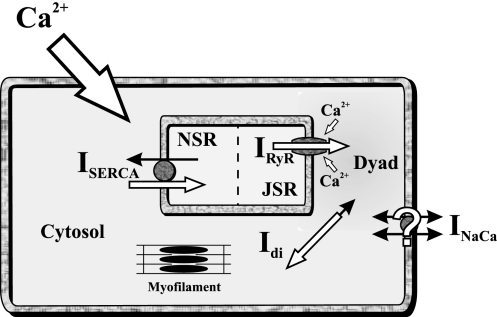Fig. 8.
Schematic of the underlying mechanism of DADs. An increase in CaTot within the cell increases the level of Ca2+ within each compartment. The increase in the dyadic subspace leads to a higher open probability of RyRs, increasing the spark rate, which, at some point, initiates a concerted opening of RyRs throughout the cell (a release). (As shown in Fig. 3, the modulation by CaSR content is influential but not essential.) The intracellular (Ca2+ subsystem) oscillations are maintained by the fast and slow time constants of diffusion, uptake, and release; in some models, NCX is necessary for the oscillations, but parameter changes in the model can make it redundant. The intracellular Ca2+ oscillations are then translated either via NCX, the Ca2+-activated Cl− channel, or nonspecific Ca2+-activated current to changes in voltage, which can eventually trigger a complete AP (see Fig. 1). ISERCA, SERCA current; NSR and JSR, network and junctional SR; Idi, diffusion current; INaCa, Na+/Ca2+ exchange current.

